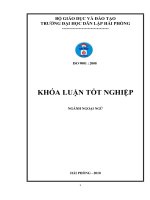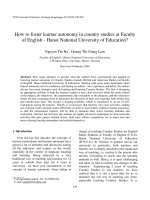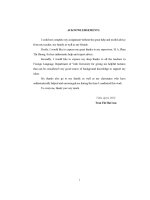A study of how to motivate second-year English majors at the Faculty of English, Hanoi National University of Education Nghiên cứu cách tạo động lực cho sinh
Bạn đang xem bản rút gọn của tài liệu. Xem và tải ngay bản đầy đủ của tài liệu tại đây (222.09 KB, 5 trang )
VIETNAM NATIONAL UNIVERSITY-HANOI
UNIVERSITY OF LANGUAGES AND INTERNATIONAL STUDIES
FACULTY OF POST-GRADUATE STUDIES
TRẦN NGỌC GIANG
A STUDY OF HOW TO MOTIVATE SECOND-YEAR ENGLISH
MAJORS AT THE FACULTY OF ENGLISH, HANOI NATIONAL
UNIVERSITY OF EDUCATION
NGHIÊN CỨU CÁCH TẠO ĐỘNG LỰC CHO SINH VIÊN NĂM THỨ
2 CHUYÊN ANH TẠI KHOA TIẾNG ANH, TRƯỜNG ĐHSP HÀ NỘI
TRONG CÁC GIỜ HỌC KỸ NĂNG NGHE
M.A THESIS
Field: English Methodology
Code: 60 14 10
Hanoi, 2010
VIETNAM NATIONAL UNIVERSITY-HANOI
UNIVERSITY OF LANGUAGES AND INTERNATIONAL STUDIES
FACULTY OF POST-GRADUATE STUDIES
TRẦN NGỌC GIANG
A STUDY OF HOW TO MOTIVATE SECOND-YEAR ENGLISH
MAJORS AT THE FACULTY OF ENGLISH, HANOI NATIONAL
UNIVERSITY OF EDUCATION
NGHIÊN CỨU CÁCH TẠO ĐỘNG LỰC CHO SINH VIÊN NĂM THỨ
2 CHUYÊN ANH TẠI KHOA TIẾNG ANH, TRƯỜNG ĐHSP HÀ NỘI
TRONG CÁC GIỜ HỌC KỸ NĂNG NGHE
M.A THESIS
Field: English Methodology
Code: 60 14 10
Supervisor: Assoc. Prof. Dr. TRẦN XUÂN ĐIỆP
Hanoi, 2010
4
TABLE OF CONTENTS
Declarations
Acknowledgement
Abstract
List of abbriviations
List of charts
Table of contents
Part 1: Introduction 1
1. Rationale 1
2. Research hypotheis 2
3. Aims of the study 2
4. Significance of the study 2
4.1. Theoretical significance 2
4.2. Practical significance 3
5. Scope of the study 3
6. Methods of the study 3
7. Design of the study 4
Part 2: Development 5
Chapter 1: Theoretical Background 5
1.1. Overview of motivation in language learning 5
1.1.1. Definition of motivation 5
1.1.2. Classification of motivation in language learning 6
5
1.1.3. The importance of motivation in language learning 9
1.1.4. Common factors affecting learners’ motivation
in language learning 9
1.1.4.1. Learners’ factors 10
1.1.4.2. Parents’ factors 11
1.1.4.3. Teachers’ factors 12
1.1.4.4. Learning materials 13
1.1.4.5. Learners’ success in language learning 13
1.1.5. Characteristics of motivated learners 13
1.1.6. General strategies to motivate students in language teaching 14
1.1.7. Maintaining and protecting the students’ motivation 18
1.1.8. Motivational macro-strategies 23
1.2. Teaching listening 26
1.2.1. What makes L2 listening more challenging than L1 listening 27
1.2.2. The importance of listening instruction 29
1.2.3. Component skills for listening 30
1.2.4. Listening ability assessment scales 31
1.2.5. How to motivate students in listening classes 33
Chapter 2: Methodology 35
2.1. The setting of the study 35
2.1.1. The students 35
2.1.2. The researcher 36
2.1.3. The syllabus and learning materials 36
6
2.2. Research hypothesis 36
2.3. The methods employed in the study 37
2.3.1. Three changes made to the listening course 37
2.3.2. The methods employed 38
2.4. The data collection procedures 41
Chapter 3: Data analysis, Findings, and Discussions 42
3.1. Data analysis 42
3.1.1. Results from classroom observation and analysis 42
3.1.2. Results from the students’ writing journals 43
3.1.3. Results from the survey questionnaires 44
3.1.3.1. Results from pre-treatment questionnaire 44
3.1.3.2. Results from post-treatment questionnaire 52
3.1.4. Results from the informal interviews with students 59
3.2. Findings and discussions 60
3.2.1. Findings 60
3.2.2. Discussions 62
Part 3: Conclusion 63
1. Recapitulation 63
2. Limitations 64
3. Suggestions for further research 64
References 66
Appendix









